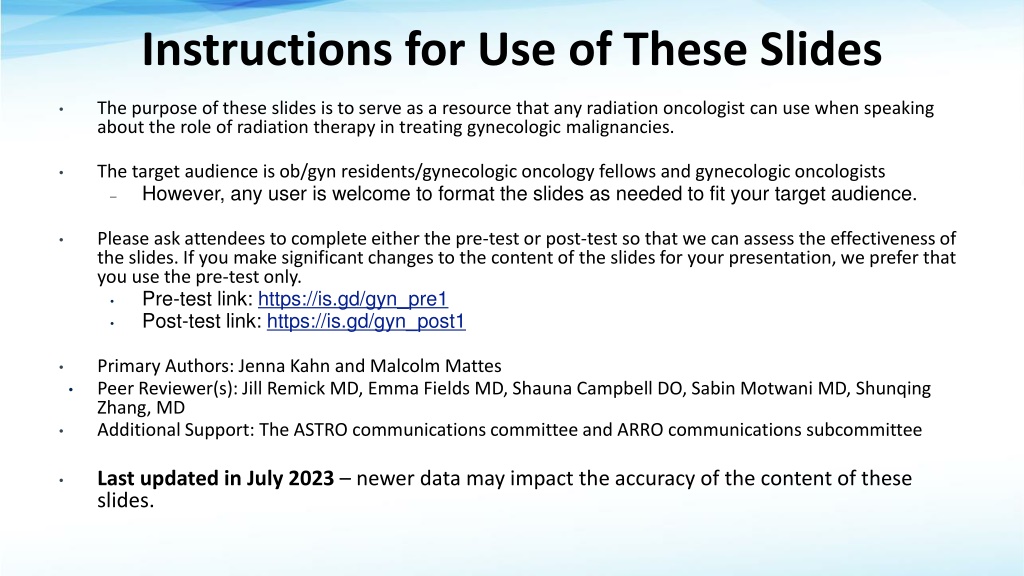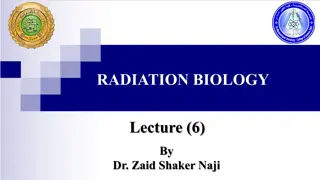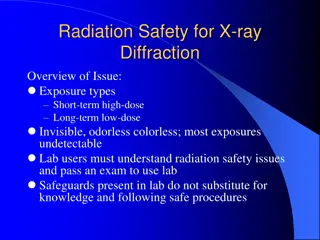Radiation Therapy for Gynecologic Malignancies - Comprehensive Overview
These slides serve as a valuable resource on radiation therapy for gynecologic malignancies. Key topics covered include radiation delivery techniques, indications for therapy, how radiation works, dosing considerations, and more. Suitable for radiation oncologists, ob/gyn residents, and gynecologic oncologists.
Download Presentation

Please find below an Image/Link to download the presentation.
The content on the website is provided AS IS for your information and personal use only. It may not be sold, licensed, or shared on other websites without obtaining consent from the author. Download presentation by click this link. If you encounter any issues during the download, it is possible that the publisher has removed the file from their server.
E N D
Presentation Transcript
Instructions for Use of These Slides The purpose of these slides is to serve as a resource that any radiation oncologist can use when speaking about the role of radiation therapy in treating gynecologic malignancies. The target audience is ob/gyn residents/gynecologic oncology fellows and gynecologic oncologists However, any user is welcome to format the slides as needed to fit your target audience. Please ask attendees to complete either the pre-test or post-test so that we can assess the effectiveness of the slides. If you make significant changes to the content of the slides for your presentation, we prefer that you use the pre-test only. Pre-test link: https://is.gd/gyn_pre1 Post-test link: https://is.gd/gyn_post1 Primary Authors: Jenna Kahn and Malcolm Mattes Peer Reviewer(s): Jill Remick MD, Emma Fields MD, Shauna Campbell DO, Sabin Motwani MD, Shunqing Zhang, MD Additional Support: The ASTRO communications committee and ARRO communications subcommittee Last updated in July 2023 newer data may impact the accuracy of the content of these slides.
Introduction to Radiation Therapy for Gynecologic Malignancies
Learning Objectives Understand the different radiation delivery techniques for women with gynecologic cancers Review indications for radiation therapy in the curative and palliative settings
How Does Radiation Therapy (RT) Work? X-rays interact with water 80% radiolysis free radicals bind to and damages DNA mitotic catastrophe cell death 20% Cancer cells are more susceptible to RT due to impaired DNA repair pathways
Radiation Dosing Gray (Gy) is the unit of RT dose 1 Gy = 100 centiGray (cGy) The dose from 1 cGy roughly equals 1 CT scan Dose prescription depends on: Goal of treatment (curative > palliative) Amount of disease (gross > microscopic) RT sensitivity of tumor RT sensitivity of surrounding normal tissue Biologically Effective Dose (BED) depends not only on total dose, but how that dose is fractionated, and the tissue irradiated Relevant to understanding EBRT vs. brachytherapy doses
Radiation Delivery Techniques External Beam Radiation Therapy (EBRT) 3-Dimensional Conformal Radiation Therapy (3-D CRT) Intensity Modulated Radiation Therapy (IMRT) Image-Guided Radiation Therapy (IGRT) Stereotactic Body Radiation Therapy (SBRT) Brachytherapy Intracavitary Interstitial
External Beam Radiation Therapy Linear accelerator(Linac) Delivers high energy X-rays Non-invasive Rapid treatment delivery, in minutes
Evolution of External Beam Radiation Therapy 3-D treatment planning using CT scan enables: 1) More accurate delineation of target and normal structures 2) Accurate dose calculation to tumor and organs at risk of toxicity so the quality of the plan can be evaluated (i.e., probability of cure or toxicity)
Evolution of External Beam Radiation Therapy Can co-register (overlay) MRI or PET with CT for more accurate target delineation Lim et al, 2009
Evolution of External Beam Radiation Therapy Use of dynamic MLCs to create irregular (non-uniform) radiation from each field and adjust the intensity around a curved target volume Enables dose escalation or reduction in toxicity 3-D CRT IMRT Klopp et al, 2018
Intensity Modulated Radiation Therapy (IMRT) IMRT 3-D CRT IMRT is commonly used to treat GYN malignancies Dosimetrist or physicist uses computer software to optimize plan based on planning objectives to conform to target while sparing other organs From consult RT start, the planning process typically takes 10-14 days Deng et al, 2016
Managing Internal Organ Motion during Simulation and Treatment Contour tumor position with empty and full bladder CTs, but treat with full bladder (to push bowel out of the way Daily image guidance (e.g., CBCT) to assess for shifts in soft tissue anatomy enables margin reduction around Sun et al, 2016 tumor
Brachytherapy Radioactive sources temporarily placed inside or around a tumor Allows for greater dose escalation by sparing normal tissue Commonly used in definitive management of cervical cancer after EBRT to boost cervix/parametrium, and in the adjuvant management of uterine cancer to treat vaginal cuff
Brachytherapy Applicator Types for Cervical Cancer Tandem and Ovoids Tandem and Ring Tandem and Cylinder Tandem and Interstitial
Hybrid Applicators with Interstitial Needles Provide additional degree of freedom to adjust dose distribution around irregular or bulky tumors Suneja and Viswanathan et al, 2020
Interstitial Templates Use for post hysterectomy, larger lesions or lower vaginal involvement Tiwari et al, 2020
Brachytherapy Dose Rate Low-Dose-Rate (LDR) Brachytherapy used to be most common Cs-137 manually placed within applicators in patient Long half life deposits dose slowly patient stays in bed, hospitalized, for 2-4 days Inconvenient and radiation safety risks High-Dose-Rate (HDR) Brachytherapy has largely replaced LDR Applicators are placed in an operative room CT scan is used to delineate target volume and applicator position(s) and optimize treatment plan (easier dose modulation) Ir-192 remotely moved through applicators in a shielded room in radiation oncology department over 10-15 minutes (no radiation safety risk) Applicators are removed and patient typically goes home same day
Remote Afterloader for HDR Brachytherapy Each catheter/applicator is connected to a Remote Afterloader A single Ir-192 radioactive source on a wire travels within each catheter into specific positions, for specific periods of time All applicators are removed after treatment
Brachytherapy Treatment Planning Modern image guided volumetric planning uses a CT scan to optimize dose based on the contoured tumor (target) and nearby normal organs Potter et al, 2006
Brachytherapy Treatment Planning Historically, treatment planning was based on 2-D X-rays, and dose was calculated based on reference points relative to the applicators or pelvic bones
MRI Guided Brachytherapy More accurate delineation of tumor extension Visnawathan et al, 2014
Clinical Outcomes of Image Guided Brachytherapy Improves pelvic control and survival for patients with cervical cancer Sturdza et al, 2016
Vaginal Cylinder Single channel cylinders come in several sizes Multi-channel cylinders offer extra control of dose distribution
Integration of Radiation Therapy into Patient Care
Overview of Clinical Management of GYN Malignancies Definitive RT (typically with concurrent chemo) is sometimes used instead of surgery as the primary curative modality Common in cervical cancer, vaginal cancer and some vulvar cancers Adjuvant RT is sometimes used after a definitive surgical resection in patients at high risk of recurrence Common in uterine cancer, and some cervical and vulvar cancers Neoadjuvant RT is uncommon for GYN malignancies Salvage RT is sometimes used for locoregional cancer recurrence after prior curative-intent therapy Palliative RT can be directed at any site of symptomatic cancer for symptom relief (e.g., pain, bleeding, obstructive symptoms)
Cervical Cancer Lim et al, 2009
Early-Stage Cervical Cancer Stages IA1-2, IB1 are typically treated with up-front surgical resection Type of hysterectomy and extent of LND is stage dependent Most recurrences after surgery alone are locoregional Post-operative pelvic external beam radiation therapy (EBRT) is indicated if patient has > 2 Sedlis criteria (correlates to recurrence risk up to 31%)
The Sedlis Criteria for Adjuvant EBRT LVSI Positive Positive Positive Negative Stromal Invasion Deep 1/3 Middle 1/3 Superficial 1/3 Deep or Middle 1/3 Tumor Size Any 2 cm 5 cm 4 cm Need 2 of 3: Positive LVSI, Middle 1/3, 4 cm Sedlis et al, 1999
Evidence for Adjuvant Pelvic EBRT GOG 92 randomized 277 patients who met the Sedlis criteria to post-op RT vs. observation RT 46% relative reduction in pelvic recurrence RT 30% relative reduction in risk of death (p=0.07) Sedlis et al, 1999 and Rotman, et al, 2006
Adding Chemotherapy to Adjuvant EBRT Indicated for patients with high-risk features (up to 40% pelvic recurrence rate) The 3 P s: Parametrium involvement (microscopic) Pelvic lymph node involvement Positive surgical margins GOG 109 (Peters et al, 2000) demonstrated that adding chemo to RT 10% absolute 4Y-OS benefit
Adding Brachytherapy to Adjuvant EBRT Vaginal cylinder indicated when high risk of local recurrence: Less than a radical hysterectomy Close or positive margin Large or deeply invasive tumor Parametrial or vaginal involvement Extensive LVSI
Definitive Chemo-RT for Cervical Cancer Radical hysterectomy + adjuvant RT has high morbidity When clinical staging suggests a high likelihood of the need for adjuvant RT after radical hysterectomy, definitive chemo-RT is preferred due to similar cure rate and reduced toxicity As a threshold, most patients with a >4cm tumor confined to the cervix/uterus (or upper vagina) would meet criteria for adjuvant radiation NCCN guidelines recommend definitive chemo-RT rather than radical hysterectomy for Stage IB3, IIA2, IIIA/B and IVA Also an option for Stage IB1-2, IA2 and IA1 with LVSI Landoni et al, 1997
Definitive Chemo-RT Treatment Scheme Integrated boost to involved nodes using IMRT also commonly used Goal treatment time <56 days improved local control
Use of Chemotherapy with Definitive RT Addition of concurrent cisplatin-based chemo the risk of death by 30-50%1-3 Several randomized trials used cisplatin/5-FU, however, weekly cisplatin is more common because better tolerated The role of consolidation outback Cis/Gem substantially increases toxicity, and is not recommended4 Carbotaxol is currently being evaluated in ANZGOG 0902 RTOG 1174 1. RTOG 90-01 (Morris et al, 1999, Eifel et al, 2004) 2. GOG 123 (Keys et al, 1999, Stehman et al, 2007) 3. Pearcey et al, 2002 4. Duenas-Gonzalez et al, 2011
Brachytherapy is a Critical Part of Definitive Management of Cervical Cancer Declining utilization in recent years has correlated with reduced survival Gill et al, 2014
Radiation Therapy Side Effects Vaginal stenosis can be prevented using vaginal dilator 15-20 minutes/day, at least twice per week Apical vaginal ulceration or necrosis (~7%) treated with estrogen cream Risk of G3+ (severe) long- term rectal, bladder or bowel toxicity is ~5%
Recurrences after Definitive Chemo-RT If central disease consider pelvic exenteration Radical hysterectomy or brachytherapy may be possible if lesion < 2cm Key selection factors to consider exenteration: no nodal or distant recurrence, excellent performance status, good social support, longer disease-free interval from initial treatment If non-central disease (pelvic sidewall) consider resection of tumor- directed RT or chemo/best supportive care Some patients with previously untreated PALN recurrence may be salvaged
Uterine Cancer Management Most uterine cancer is treated with up-front surgery Adjuvant radiation and/or chemotherapy are indicated for some patients based on pathologic stage, grade and other risk factors If patient is not suitable for up-front surgery (medically inoperable or surgically unresectable) but not metastatic, pelvic EBRT +/- brachytherapy +/- systemic therapy should be considered
Risk Stratification for Adjuvant Therapy Low Risk: Endometrioid adenocarcinoma, grade 1-2, Stage IA no LVSI No role for adjuvant treatment Intermediate Risk: Stage I-II (stratified into low or high intermediate risk primarily based on tumor grade, stage, presence of LVSI and patient age) Risk of locoregional > distant recurrence, so RT > chemo High Risk: Endometrioid adenocarcinoma Stage III/IV or deeply invasive G3 (Stage IB or higher), or serous or clear cell histology of any stage Higher risk of distant recurrence, so chemo is often indicated Role of RT is dependent on other locoregional risk factors + use of chemo
Definition of Low- vs. High-Intermediate Risk For uterine confined disease, treat based on the presence of high- intermediate risk factors - definition varies in different studies
Key Studies for Intermediate Risk Uterine Cancer GOG 99 and PORTEC-1 established that pelvic EBRT reduces locoregional recurrence from approximately 12-15% 3-5%, with most of benefit in patients with high-intermediate risk features1-2 PORTEC-2 established comparable efficacy but less toxicity for brachytherapy compared to pelvic EBRT3 5-Year Outcomes Vaginal Brachy Pelvic EBRT p-value Locoregional Relapse 5.1% 2.1% NS Vaginal Relapse 1.8% 1.6% NS Pelvic Relapse 1.5% 0.5% NS Distant Relapse 8.3% 5.7% NS Overall Survival 85% 80% NS Acute G1-2 Toxicity 13% 54% P < 0.05 GOG 249 established that chemotherapy has less of a role in high intermediate risk patients due to increased risk of acute toxicity compared to EBRT (64% vs. 11%) but no difference in recurrence-free or overall survival4 1. Keys et al, 2004 2. Creutzberg et al, 2000 3. Nout, RA et al, 2010 4. Randall et al, 2019
LVSI: Substantial vs. Focal Substantial LVSI > 4 foci Risk factor for local and distant recurrence Pooled analysis of PORTEC 1-2 studies 3-tiered system most prognostic for RR, DM and OS Tier 5-year risk of RR No LVSI 1.7% Focal LVSI 2.5% EBRT: 4% Substantial LVSI (5%) (diffuse or multi-focal) 15% VBT: 27% Obs: 31% Bosse et al. Eur J Cancer (2015)
NCCN Adjuvant Therapy Guidelines for Uterine-Confined Disease Low Risk Low Int Risk High Int Risk High Risk Intermediate Risk Factors: 60, focal LVSI High Risk Factors: substantial LVSI, especially without nodal staging
Molecular Subtype Pooled analysis of PORTEC Patients: 4 molecular prognostic groupings: BEST: POLE mutated Copy number low (No specific profile) MSI hypermutated (MMRd) WORST: Copy number high/p53 Kandoth, et al, 2013 Stelloo et al. 2016
Molecular Subtyping Algorithm M<M Masood m, Singh, N. Endometrial Carcinoma: changes to classification (WHO 2020). Diagnostic Histopathology. 2021 Masood et al, 2021
PORTEC-2: 10 yr Update and Pathology and Molecular Analysis High risk factors: - Substantial LVSI - p53-mutant and/or - L1CAM expression Wortman et al, 2018
Adjuvant Therapy for High Risk Uterine Cancer Approach depends on stage, histology and other risk factors Higher risk for distant mets greater benefit of chemo Clear cell or serous- histology, Stage IA or II with myometrial or cervical invasion Clear cell or serous- histology, and stage IA without myometrial invasion G3 endometrioid Adenocarcinoma, Stage IB or II Stage III-IV of any histology VBT or observation *Chemo +/- VBT EBRT or chemo, +/- VBT *Use EBRT if not chemo candidate, or may favor EBRT over chemo for clear cell histology (data is limited)
Evolution of Treatment Paradigms for Advanced Endometrial Cancer U.S. Standard of Care European Standard of Care WPRT alone Italian Study Maggi et al 2006 JGOG 2033 Susumu et al 2008 Chemotherapy alone GOG 122 Randall et al 2006 Regional Recurrence: 20% Distant Recurrence: 25- 30%
Evolution of Treatment Paradigms for Advanced Endometrial Cancer GOG 258 PORTEC-3 Eligibility: - Stage III-IVA - Stage I-II serious or clear cell AND positive peritoneal histology (<5%) - 2cm residual disease - s/p TAH/BSO, LND optional (94%) Eligibility: - - - Stage IA G3 with LVSI; Stage IB G3 Stage II-IIIC EC Stage IA-III serous or clear-cell histology (25%) s/p TAH/BSO, LND optional (58%) - C-RT (n=343) Cis-RT +/- VBT Chemo (Carbo/taxol x 4c) C-RT (n=370) Cis-RT +/- VBT Chemo (carbo/taxol x 4c) Arm 1: Experimental Arm 2: Standard Chemo alone (n=366) Carbo/taxol x 6 c RT alone (n=343) EBRT 48.6 Gy +/- VBT























